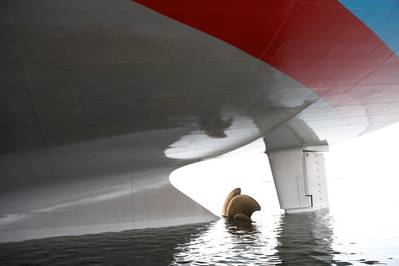'Emma Maersk' Likely Months Out of Service
Palle Laursen, Head of Ship Management for Maersk Line, shares the latest update on the 'Emma Maersk' Suez incident.
Initial inspections by divers show that the water ingress was caused by damage to one of the stern thrusters. Thrusters are used for improving the vessels manoeuvrability and consist of a shaft tunnel fitted with a propeller delivering sideways thrust. It is now known that several propeller blades have broken off and there is severe damage to the propeller mounting, resulting in a crack in the forward stern thruster tunnel which caused the ingress of water.
The water flooded the engine room which consequently led to the loss of main engine power, and Emma Maersk was towed to the quay at Suez Canal Container Terminal.
While it is still unclear what caused the damage, Palle rules out any human error by the crew. “The crew handled the situation very well and did exactly what they should at all stages,” he says.
“The E-class has been sailing well since 2006, and the thrusters are used at every port call,” Palle adds, stressing that for now it is seen as an isolated incident. “Until we know the exact reason, however, we have as a precautionary measure instructed the other vessels in the E-class fleet not to use their stern thrusters.”
At no point was Emma Maersk in danger of sinking. Naval architects have confirmed that a fully loaded E-class vessel can sustain full flooding of the engine room and still stay afloat. Large container vessels have a natural better stability than smaller vessels. Had the incident occurred at sea, it would have been a matter of getting an oceangoing tugboat in place to assist.
Fixing a hole
Making Emma Maersk seaworthy again is a complicated process, and Palle admits it is probably a matter of months before she can enter service again.
The first priority is to preserve the equipment, which ironically means keeping it submerged for the time being. Due to its exposure to salt water, any contact with oxygen will result in corrosion. So the plan is to have underwater welders plug the hole before lifting the vessel further, after which the remaining cargo onboard will be unloaded, water will be pumped out, and the equipment will be washed with fresh water, dismantled and retrofitted.
All this may sound simple enough, but there are several uncertainties, says Palle. It is still unclear whether a full dry-dock operation is needed, for instance. Even if it can be done while the vessel is waterborne, there is the question of location: is Suez suitable for the operation, or is it necessary to tow the vessel to another location?
These and other questions will be determined during the coming days and weeks.














